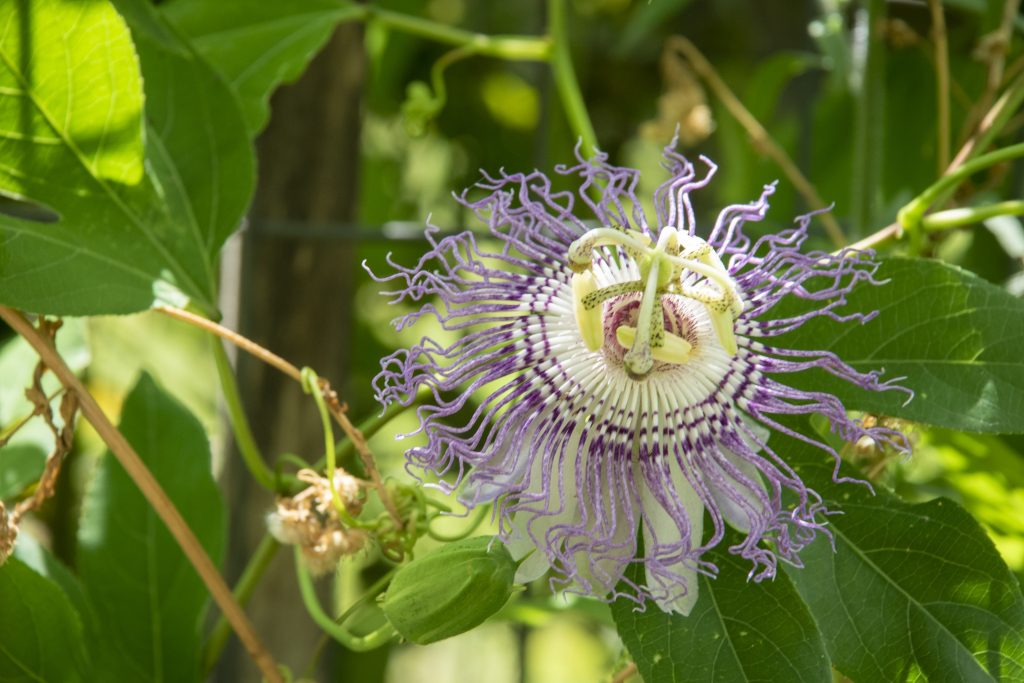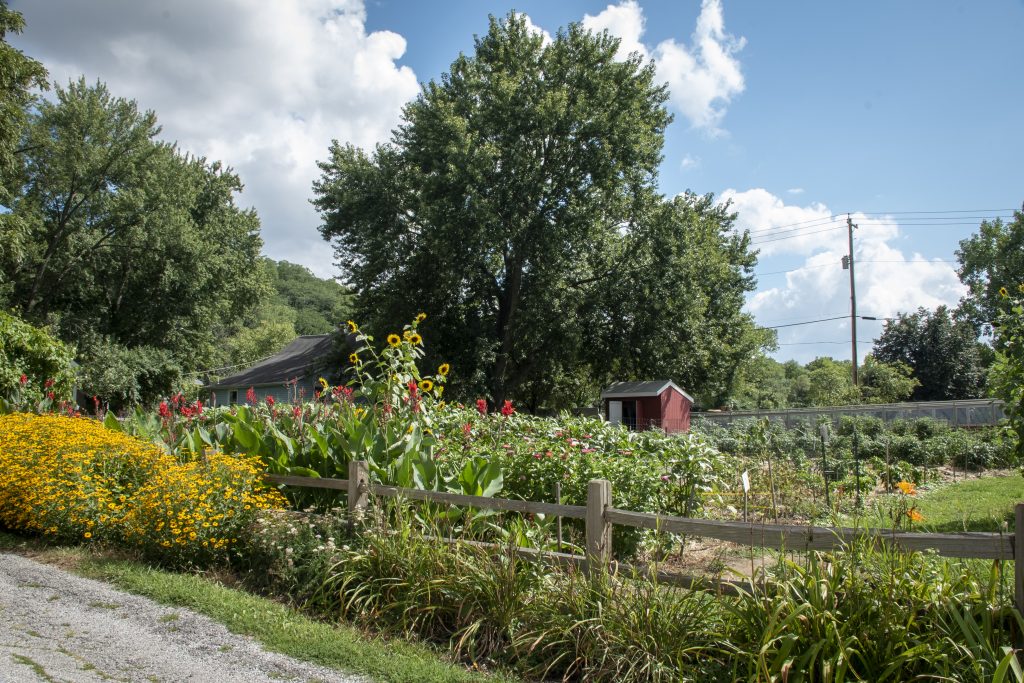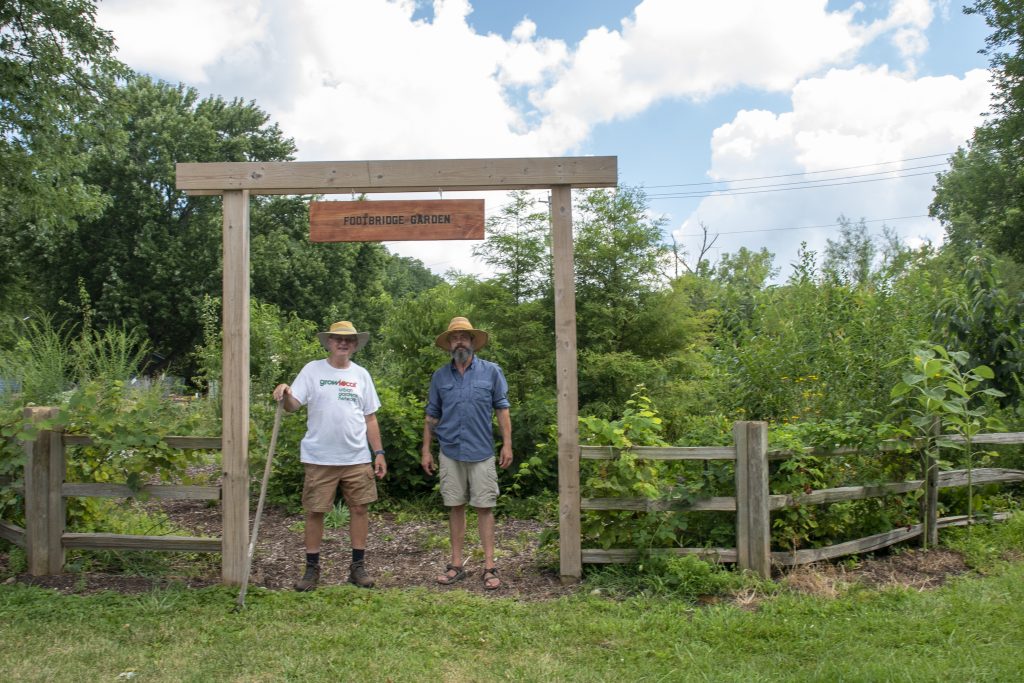BY AMY LONG
PHOTOS BY CHRISTINE PETKOV
Tucked at the end of a dead-end street, the Footbridge Garden feels cut off from the rest of the world. Stand in the middle of the lush plot with your eyes closed as the leaves of the fruit trees rustle in the breeze, and it’s easy to imagine that you’re the only soul for miles around.
That is, until the roar of a nearby Norfolk Southern freight train interrupts the reverie. Open your eyes to glimpse rows of trash and recycling bins perched along the alley and the magnificent dome of the Tippecanoe County Courthouse looming over downtown Lafayette, only a half-mile to the north, and you realize that the garden was not designed to be a remote retreat. It’s supposed to be accessible. Within reach. Open to all. In the center of town.
Welcome to Footbridge Garden, a verdant fruit and vegetable patch that’s part of a network of 10 sharing gardens in and around downtown Lafayette called GrowLocal. The grassroots group formed in 2015 with the goal of building, nourishing and nurturing community through urban gardening.
Each sharing garden in the GrowLocal network is open to the public. There’s no membership required, no entrance fee and no plots for rent. The garden’s bounty is available to whomever wants to stop by to harvest it. All that’s asked of those who partake is that they contribute a little sweat equity. A sign at the entrance says, simply, “Take what you need, pull a weed.”
“I think there are people who pick from the garden, and they do it specifically when we’re not here, because they’re not sure they should, or can,” says Margy Deverall, one of GrowLocal’s founders. “When we do stop people and talk to them, we say, ‘Do you live around here? Well, this is your garden, too! There are strawberries over there that need to be picked. Go ahead!’ And they’re surprised.”
Deverall and Ken McCammon, longtime friends and experienced community organizers, hatched the idea of GrowLocal about nine years ago as they brainstormed a way to share resources — including knowledge, experience and people power — across a couple of community gardens.
At the time, Deverall worked in economic development for the City of Lafayette. Part of her job included neighborhood outreach, so she started a small garden on an unused wedge of city property on Erie Street. McCammon, who worked for a seed company and had access to inexpensive vegetable transplants, had started a garden at a downtown church as part of his involvement in a local neighborhood association.


“We were talking, and it’s like, ‘You’ve got a garden. I’ve got a garden. There are probably other people that have gardens. Why don’t we put a call out and see if anybody’s interested in working together?’ ” McCammon recalls. Others responded to their call, and a small network started to grow. But the idea of a network of sharing gardens didn’t come up until Harry Smith joined the group. An experienced horticulturalist, Smith had started a sharing garden at his church, and he explained the concept to the group.
“I had never heard that expression before,” says Deverall. “When he said, ‘It’s just one big garden and anybody can come and help,’ well, we liked that idea!” Because she worked in economic development, Deverall recognized that most of the gardens in their growing network were in a food desert — an area defined by the U.S. Department of Agriculture as having a high rate of poverty, inadequate access to transportation, and a limited number of grocery stores offering fresh produce and healthy food.
“Based on census data, those are in low-income neighborhoods where we knew there was food insecurity,” Deverall says. “It seemed like this is where we just want to grow food, and anybody walking by who needs it can pick it.” The organization’s mission statement and core values — which include building community, enhancing quality of life, inspiring healthful attitudes and actions, and providing access to healthy food and resources — practically wrote themselves.
The organizational structure of the all-volunteer network is straightforward. A small team that includes Deverall, McCammon and Smith handles most of the administrative tasks, including fundraising (they simply launch an online crowdfunding campaign each fall), grant writing and purchasing supplies. McCammon is friendly with a grower and distributer who donates thousands of vegetable transplants each year, and the GrowLocal leaders distribute them across the network in the spring.
By design, GrowLocal does not have its own 501(c)3 designation. As president of Friends of Downtown, a well-established nonprofit organization that promotes the vitality of downtown Lafayette, McCammon tucked the urban garden network under his organization’s community-building umbrella and maintains a column for GrowLocal on its balance sheets.
“All we want to do is garden,” Deverall says. “We don’t want to mess around with paperwork.”
So, GrowLocal doesn’t own the plots of earth. Rather, the member organizations — places such as churches and community centers — own the land, and when they signed on with the network, they agreed to provide water, a garden manager and a pool of volunteers. When there’s work to be done, garden managers rally their troops — usually by posting on Facebook — and available workers show up to plant, water, weed, spread mulch and mark rows.
Footbridge Garden, at 244 Smith St. in Lafayette, is part of a larger tract of land that was left over after a railroad relocation project and eventually bequeathed to Habitat for Humanity of Lafayette, which partners with low-income families to build affordable homes. This particular lot — hemmed in by a pedestrian bridge that spans the nearby tracks and a narrow alley on the other side — cannot be developed because it lacks street frontage and access to utility lines. So, shortly after the garden network officially organized, Habitat leaders approached the folks at GrowLocal to offer their space — almost a third of an acre — as a garden.
“It’s truly an unused city lot that can’t be put to much other purpose,” says Smith, who volunteers as the garden manager there. “The property is still [owned by] Habitat. And they basically turned it over to us to garden.”
Mulched paths criss-cross the broad plot and separate the annual garden at one end — where crops like tomatoes, eggplants, carrots, okra, sweet peppers and summer squash grow in long rows — from the perennial garden — a jumble of berry bushes, and fruit and nut trees.
Janet Clift, who lives a half-mile from Footbridge Garden, says she spends about an hour a week there in the summer, weeding and harvesting. She says she’s active in the garden, not just because sharing food is a noble cause, but because building a community is important to her.
“People in the community come and experience gardening, even if they don’t do it at home,” Clift says. “Even if someone’s not comfortable with it, they can’t keep up with it, or they’re not going to maintain it all summer, they can come and participate. And then they get to eat fresh produce that was made right in their home town, right down the street from them. And it’s just so cool.”
After school starts in August, gaggles of second-graders from Miller Elementary School a few blocks away make their way to the garden for a literal field trip — part of a broader GrowLocal outreach plan.
“It’s 45 minutes of chaos,” Smith says. “We kind of learned after the first year that you don’t really plan any curriculum. The kids drive the curriculum. They start asking questions the minute they walk in.”
“They go to that school. That means they probably live nearby,” Deverall says. She encourages the kids to come back with their parents, or grandparents, and to show them that they can pick from the garden, too.
A challenge, of course, is that the garden is open to everyone at all hours, while a volunteer garden manager is only on-site a few hours per week. “You always expect that if you put something out that’s free and you don’t watch it, somebody’s going to come and take everything,” says Clift, the neighborhood volunteer. “I don’t know if it’s because there’s so much, but it feels like people don’t abuse it.” GrowLocal organizers say there have only been a few issues — though not with vandalism or abuse of the space. The biggest problems have been with well-intentioned gardeners harvesting a little too vigorously. A crop of asparagus, for example, was mowed down before the crowns could establish underground.
“That’s the challenge,” Deverall says. “The gardens are here all the time, and you’re not here to educate people. So how do you educate people?” GrowLocal organizers solved the problem by making signs that identify the produce, explain when to pick it, and offer QR codes with links to recipes.
Because GrowLocal organizers will never be able to fully preside over the gardens, they will never be able to know exactly how many people are benefiting from them, or how much food they are harvesting. Most philanthropic groups can carefully track the populations they serve and the metrics that propel their mission statements, but the folks at GrowLocal are only just starting to participate in studies that estimate crop yield and gauge the group’s socio-economic impact.
“We’re not there, yet. But we’re growing in that direction,” says Smith. Until then, he adds, “We can’t really say that so many thousands of pounds of produce went here or there. But if it’s disappearing, we’re happy.” ★





